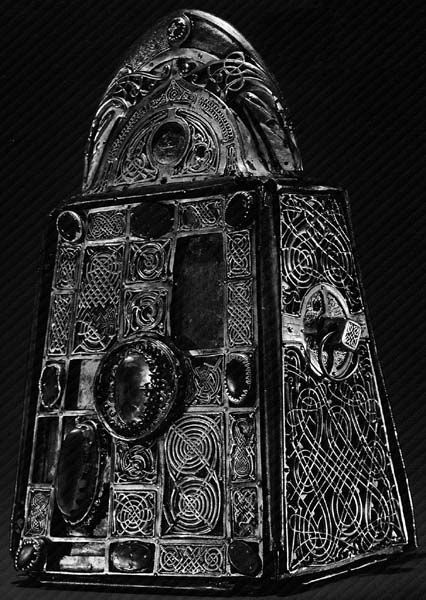 |
| http://www.celticfestival.ca/fr_home.cfm |
This year marks the 20th anniversary of the Celtic Festival. (August 10 - 12, 2012)
At this point I am the only artisan to have attended every single year since the start. Over the years I have also been a feature demonstrator, illustrating some aspect of historic metalworking methods Saturday and Sunday afternoons. I have also taught at the associated Celtic College every year it has been in operation. (August 6 - 9)
Those in regular attendance at the Festival have seen how I have slowly incorporated elements of history and experimental archaeology into my presentations. I feel it is necessary to understand the real past of Celtic culture, if we are to fully appreciate its modern expressions. The 'Celtic Roots' of the current visual arts are based on ancient objects. Knowing these forms, and understanding the physical techniques that created them, is fundamental to a true understanding of the Celtic World.
 |
| 'St Padric's Bell Shrine' |
Those who know me well also realize that I am the 'Norseman in the woodpile'. My initial interest in ancient artifacts and design was actually focused on Celtic Iron Age and the later 'Book of Kells' material cultures. But I got swept up in the Viking Age, and have concentrated my studies and work there. Perhaps not so curiously, my favourites among ancient objects come from the period circa 800 - 1000 from Ireland. At that time and place there was a collision between Norse and Celtic, pagan and Christian, and the artistic styles reflect this blending. Both Celtic and Norse cultures were well known for the brilliance of their metalworking skills, and this also shows in these objects.
So this year I wanted to do something quite different.
Ancient Iron : Smelter to Forge in the Celtic Iron Age
Celtic College Course Proposal / Description
The Celts were one of the first primary 'Iron Age' cultures, with iron the materials for tools, weapons and decorative objects. How was iron actually made? Then having an iron bar, how did they work it?
This is an intensive program, limited to four students. A historic style charcoal ground pit forge will be built, using hand bellows for air, and small artifact type block anvils. Students will directly experience the challenges this equipment presents by making a number of simple objects. Work will include making a cloak broach and simple knife blade, working with actual antique wrought iron.
Norse Sand Table Forge
On the last day of the program, students will build an actual iron smelting furnace. They will also assist in preparing materials for a full demonstration smelt to take place Saturday at the Festival. This is a day long special event to mark the 20th anniversary, which interested students will be able to directly take part in.
Requirements: Students must wear long pants and closed shoes to class, other safety equipment will be provided.
Previous experience blacksmithing helpful, but not required.
Materials fee: There is an additional course fee of $20 (per student) to cover charcoal and wrought iron materials.
This will be a half day session, Monday through Thursday (exact time periods to be determined)
Those students interested in pre-booking this course should contact me via e-mail.
Physical Demonstration for Festival
Bloomery Iron Smelt
As in past years, the featured demonstration will echo the courses offered at the Celtic College. A cornerstone for Festival goers, Darrell's ongoing demonstrations on Saturday and Sunday afternoon always educate and entertain.
Although best known from their cast bronze artifacts, the Celts were one of the first primary Iron Age cultures. It was iron, forged into tools and weapons, which allowed the Celts to have such a dramatic impact on all of Europe.
But just how did they make iron in the first place? I turns out that the exact processes used by the ancients are unknown, for our modern methods are vastly different. To mark the 20th Anniversary of the Earth, Air, Fire and Water Festival, a unique demonstration is planned. One which will employ these forces at their most elemental level.
Extracting the Bloom
Drawing on over a decade of experimental archaeology research, a team will build, prepare, then fire, an ancient styled bloomery iron furnace. This process will take some 8 hours, culminating in the extraction of 5 - 10 kg white hot bloom mass.
Supported by individuals from the Dark Ages Re-creation Company, Darrell is the single most experienced 'iron master' in Canada, and one of the very few working with these techniques in North America.
The Celtic College program outlined above is a ambitious one, representing an absolutely unique learning opportunity. For the program to go ahead, a minimum of * four registered students * will be required.
The iron smelt at the Festival itself will be undertaken reguardless of this. To ate, this will be only the * fourth time in Canada * this type of demonstration has been mounted at a major public event.
Hope to see you there!






















No comments:
Post a Comment